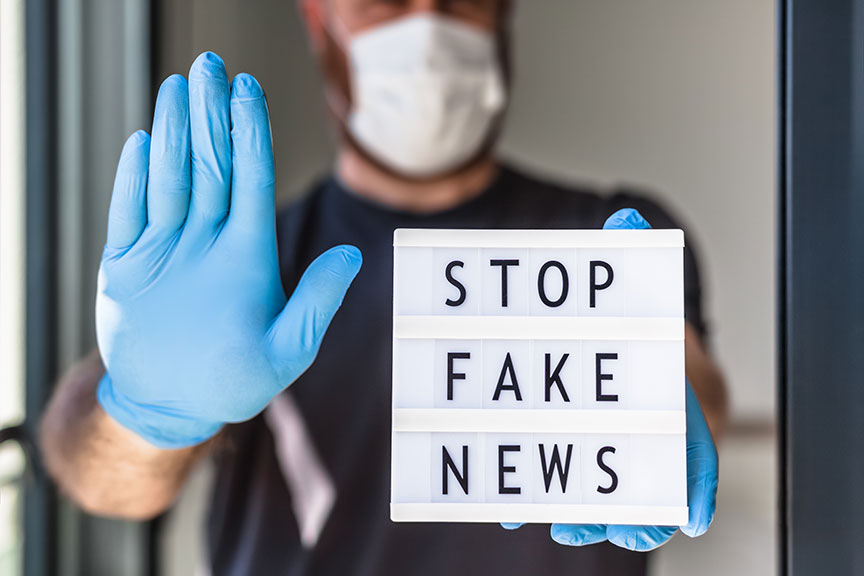What Will It Take to Eradicate Fake News?

By David Jenkins
Maybe you felt that your favorite political candidate had an unfair advantage or disadvantage. Maybe you’re upset that more people aren’t trusting scientific recommendations on a given issue. Or maybe you’re just tired of hearing your uncle broadcast his crazy conspiracy theories.
Whatever the case, you’ve inevitably felt the impact of fake news on your personal life. And whether you realize it or not, you’ve probably fallen for at least one fake news headline in the past few years.
Nobody, save for a few profit-seeking manipulators, thinks fake news is a good thing. We all recognize it as a problem, impeding our pursuit of truth, instigating further divisions in an already fractured society, and swaying major political events in volatile and unpredictable ways.
In the wake of the 2016 Presidential election, fake news was a major talking point, and tech companies like Google and Facebook made announcements decrying fake news – and pledges that they’d fight back against it. Despite these pledges (and a handful of serious efforts to combat fake news), we still have a serious problem on our hands.
So what will it take to eradicate fake news once and for all?
Media and the Internet
The fake news problem is a complex one because of the modern landscape of media, the news, and the internet. Just a few decades ago, people relied on a handful of major broadcasting companies and newspapers to keep them informed; these institutions had journalistic integrity (or at least, we perceived them as having journalistic integrity) and would do their best to state only the facts – and only once those facts were verified.
But in the modern era, news and information circulate in different, less controllable ways.
Consider:
- Self-reporting and individual platforms. Thanks to social media and the ready availability of blogging platforms and website creation tools, anyone can become a “journalist.” You don’t have to go to school. You don’t have to hold yourself to journalistic standards. You just need a website and some time on your hands. And because these individuals are capable of writing and distributing posts in the same way that major news companies do, it’s hard to tell the difference between a vetted article and a half-baked one.
- Pressure to make money. Media companies used to rely on subscriptions and broadcast television advertising dollars to stay afloat. But these days, people rely on getting their news online, for free, and instantaneously. This puts extra competitive pressure on previously prestigious publishers to rush their work and sensationalize their news.
- Competition and speed. Being successful in any kind of publishing context is no longer about creating the best work or assembling all the facts; it’s about publishing fast. The first organization to break a story has a huge advantage, so there’s an incentive to start reporting before you know all the details – and possibly fill in the gaps with speculation.
- Fake news as a tool. It’s also worth noting that savvy marketers, politicians, and influencers can intentionally create fake news to use it to their advantage. Because of the illusory truth effect, people are more likely to believe something is true if they see it often enough; in other words, even if your audience knows your news is fake, they may be inclined to believe it if you can distribute it wide enough. Fake news is also controversial, and controversy sells.
These effects are natural byproducts of our hyper-connected age. We certainly don’t want to take a technological step backward and forfeit the advantages of our connectedness; that means the only option is to keep pushing forward toward a new era of technology without such competitive or user demand-based pressure.
“Fake” Is in the Eye of the Beholder
The complexities of resolving the fake news problem don’t end there. There’s an old anecdote about newspaper stories in the Cold War covering a race between an American car and a Soviet car. The two cars race, and the American car wins. But Soviet headlines report the following: “There was a race involving a Soviet Car and an American car this weekend. The Soviet car came in second, while the American car came in second to last.”
This statement isn’t factually untrue, but it’s misleading. Would you characterize this as “fake?”
Blatant falsehoods are easy to catch for anyone paying close attention to what they’re reading. But the more insidious problem with fake news is wrapped up in this subtle manipulation. Skilled writers can distort the truth and lead people to false conclusions without ever telling a lie. The only good news, if you can call it good news, is that this isn’t a new problem; it’s something we’ve been dealing with as a society for centuries, if not millennia. It’s only now, in the era of internet-inspired transparency, that we’re able to notice it.
An Unsolvable Problem?
Based on the analysis in this document, fake news appears to be something of an unsolvable problem. Until we make technological breakthroughs that put an end to the “early internet” era or develop AI-based tools that can detect subtle falsehoods as well as blatant ones, there’s no way we could fully eradicate fake news. Instead, we have to become better critical thinkers as individuals, and choose to patronize institutions that sacrifice speed and competitiveness for truth and accuracy. In time, we can impose new pressures on journalists and institutions from the ground up – and start incentivizing integrity over distortion and sensationalism.
 >
>